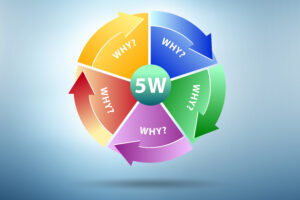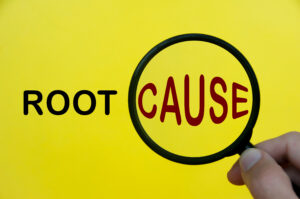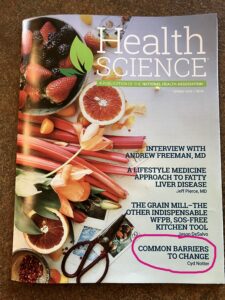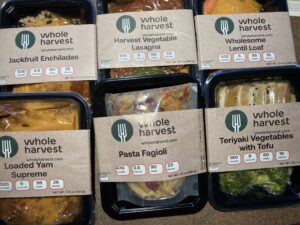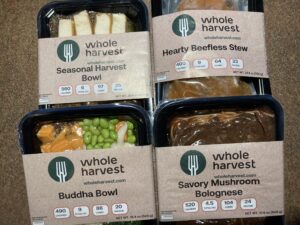(The following is an excerpt from the book, The "Plan A" Diet.)
The 5 Whys Technique
Several years ago, my husband shared with me an interesting technique that automotive manufacturers use to analyze the root cause of problems in their manufacturing processes. The Toyota Motor Corporation originally used this technique—called the 5 Whys—as a problem-solving activity to determine the underlying causes of any glitches in their systems or products.
The nature of a problem, as well as the solution, can become clear by asking the question why five times. The number five is just a guideline. It may take only three questions to reach a conclusion, or it might take six or more; but this questioning method prompts deeper thinking by repeatedly asking why until you get to the bottom of an issue.
A very simplistic example shown on Wikipedia[i] reads as follows:
- Problem: The vehicle will not start.
- Why? - The battery is dead.
- Why? - The alternator is not functioning.
- Why? - The alternator belt has broken.
- Why? - The alternator belt was well beyond its useful service life and not replaced.
- Why? - The vehicle was not maintained according to the recommended service schedule. (Fifth why - the root cause)
The solution, therefore, is to assure the vehicle and its belts are maintained according to the service schedule.
I love the simplicity of The 5 Whys...
...and the moment my husband explained it to me, a light bulb came on in my head: What a great way to get people thinking about the cause-and-effect of food!
Although The 5 Whys can be used as a tool to evaluate all types of problems, I believe it can be especially effective when dealing with health issues. Not only can it help identify the root cause of a medical problem, it can save the hassle, time, and money that might have otherwise been spent pursuing a perceived but ineffective solution.
It’s wise to write your questions and answers on a sheet of paper and continue asking why until you get to the bottom of things. Ask friends or family to join you in this exercise; group think can lead to other ideas and thought patterns. Here’s one simplified example of how it might look:
Problem: Diagnosis of Type 2 Diabetes
-
- Why? There’s too much glucose in the blood.
- Why is there too much glucose? The glucose remains in the bloodstream because it can't get where it needs to go - the intended muscle cells. (Picture each cell as having a door with a lock on it. Insulin is the key that “unlocks” the cell’s door and allows glucose to enter. Having excess glucose in the bloodstream indicates the insulin isn’t unlocking the cell’s door.)[ii]
- Why isn’t the insulin unlocking the cell’s doors? The cells have become resistant to insulin.
- Why are the cells insulin resistant? Excess fat has accumulated inside the cells. The cell’s locks are gummed up and compromised by intramyocellular lipids (fat), which interferes with insulin’s ability to open the doors.
- Why are the cells compromised with fat? Fat from the bloodstream has built up inside the muscle cells and is blocking the pathway process. (It should be noted here that even slim people can accumulate fat within the muscle cells.)
- Why is there fat in the bloodstream? Most likely the consumption of a high-fat, Standard American Diet (or the fat produced from one’s own fat stores).
When diet is deemed to be the root cause of the problem...
...the solution becomes clear: choose to change the foods being consumed. Doing so allows the body to stop the on-going damage being done three times a day and begins the healing process needed to reverse the underlying issue.
Unfortunately, most healthcare providers aren’t telling you that.
The medical system is instead geared primarily to treat your symptoms and control your blood biomarkers—which usually occurs at the first why. As a result, the underlying problem remains unresolved and continues to worsen slowly because the prescribed treatment doesn’t deal with the real issue—the food.
Using the 5 Whys technique can be an eye-opening exercise to help you discover the root cause of a health issue. So be like a curious toddler and keep asking why until you get a satisfactory answer.
One caveat with The 5 Whys technique:
The 5 Whys technique is limited to a person’s knowledge base. If the knowledge base doesn’t exist to examine the issue logically or ask the right questions, the root cause may not be fully understood. For this reason, I always encourage clients, friends, and readers to stay engaged in continual learning when it comes to diet and health.
Heed the principle of Proverbs 18:15—be an intelligent person who is always ready to learn.
The more you understand how food affects every system in your body, the better equipped you’ll be to overcome your weight and health issues by recognizing their root cause. So please continue to learn and stay in the loop!
One way to keep learning is with this free class, "3 Food Mistakes Which Lead to Painful Joints, Extra Pounds, and Health Problems the Doctors Aren't Solving." Check it out!
The Resource section on this site also lists websites which offer free webinars and instructional videos from credible doctors, daily blogs from renowned researchers, educational DVDs, books, and much more.
**********************************************
[i] Wikipedia, “5 Whys.” Accessed January 13, 2018. https://en.wikipedia.org/wiki/5_Whys
[ii] Dr. Michael Greger, “What Causes Insulin Resistance?” Dated January 6, 2017. Accessed January 13, 2018. http://nutritionfacts.org/video/what-causes-insulin-resistance/
